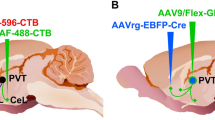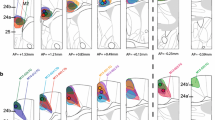Abstract
The nucleus reuniens (RE) of the midline thalamus has been shown to strongly innervate structures of the limbic forebrain, prominently including the hippocampus (HF) and the medial prefrontal cortex (mPFC) and to exert pronounced excitatory effects on HF and mPFC. It was unknown, however, whether RE projections to, and hence actions on, the HF and mPFC originate from a common or largely separate groups of RE neurons. Using fluorescent retrograde tracing techniques, we examined the patterns of distribution of RE cells projecting to HF, to the mPFC or to both sites via axon collaterals. Specifically, injections of the retrograde tracers Fluorogold (FG) or Fluororuby (FR) were made in the mPFC and in various subfields of HF and patterns of single (FG or FR) or double labeled (FG + FR) cells in RE were determined. Pronounced numbers of (single) labeled neurons were present throughout RE with FG or FR injections, and although intermingled in RE, cells projecting to the mPFC were preferentially distributed along the midline or in the perireuniens nucleus (pRE), whereas those projecting to HF occupied a wide mediolateral cross sectional area of RE lying between cells projecting to the mPFC. Approximately, tenfold more labeled cells were present in RE with ventral compared to dorsal CA1 injections. Like single labeled neurons, double labeled cells were found throughout RE, but were most densely concentrated in areas of greatest overlap of FG+ and FR+ neurons or mainly in the lateral one-third of RE, medial to pRE. Depending on specific combinations of injections, double labeled cells ranged from approximately 3–9% of the labeled neurons. The nucleus reuniens has been shown to be a vital link in limbic subcortical–cortical communication and recent evidence indicates a direct RE involvement in hippocampal and medial prefrontal cortical-dependent behaviors. The present findings indicate that RE is critically positioned to influence the HF and mPFC, and their associated behaviors, via separate or collateral projections to these sites.














Similar content being viewed by others
Abbreviations
- CA1,d,v:
-
Field CA1 of Ammon’s horn, dorsal, ventral division
- CA3:
-
Field CA3 of Ammon’s horn
- DB:
-
Double labeled cell
- DBS:
-
Deep brain stimulation
- EC, l, m:
-
Entorhinal cortex, lateral, medial division
- FG:
-
Fluorogold
- FR:
-
Fluororuby
- HF:
-
Hippocampal formation
- IL:
-
Infralimbic cortex
- MCS:
-
Minimally conscious state
- mPFC:
-
Medial prefrontal cortex
- mt:
-
Mammillothalamic tract
- PFC:
-
Prefrontal cortex
- PL:
-
Prelimbic cortex
- pRE:
-
Perireuniens nucleus of thalamus
- PT:
-
Paratenial nucleus of thalamus
- PV:
-
Paraventricular nucleus of thalamus
- PVHy:
-
Paraventricular nucleus of hypothalamus
- RAM:
-
Radial arm maze
- RE:
-
Nucleus reuniens of thalamus
- RH:
-
Rhomboid nucleus of thalamus
- slm:
-
Stratum lacunosum moleculare
- SMT:
-
Submedial nucleus of thalamus
- SUB,v:
-
Subiculum, ventral division
- VS:
-
Vegetative state
- 3V:
-
Third ventricle
References
Bertram EH, Zhang DX (1999) Thalamic excitation of hippocampal CA1 neurons: a comparison with the effects of CA3 stimulation. Neuroscience 92:15–26
Bokor H, Csáki A, Kocsis K, Kiss J (2002) Cellular architecture of the nucleus reuniens thalami and its putative aspartatergic/glutamatergic projection to the hippocampus and medial septum in the rat. Eur J Neurosci 16:1227–1239
Canteras NS, Goto M (1999) Connections of the precommissural nucleus. J Comp Neurol 408:23–45
Castaigne P, Lhermitte F, Buge A, Escourolle R, Hauw JJ, Lyon-Caen O (1981) Paramedian thalamic and midbrain infarct: clinical and neuropathological study. Ann Neurol 10:127–148
Cavdar S, Onat FY, Cakmak YO, Yananli HR, Gülçebi M, Aker R (2008) The pathways connecting the hippocampal formation, the thalamic reuniens nucleus and the thalamic reticular nucleus in the rat. J Anat 212:249–256
Davoodi FG, Motamedi F, Naghdi N, Akbari E (2009) Effect of reversible inactivation of the reuniens nucleus on spatial learning and memory in rats using Morris water maze task. Behav Brain Res 198:130–135
Davoodi FG, Motamedi F, Akbari E, Ghanbarian E, Jila B (2011) Effect of reversible inactivation of reuniens nucleus on memory processing in passive avoidance task. Behav Brain Res 221:1–6
Deliac P, Richer E, Berthomieu J, Paty J, Cohadon F, Bensch C (1993) Electrophysiological development under thalamic stimulation of post-traumatic persistent vegetative states. Apropos of 25 cases. Neurochirurgie 39:293–303
Dolleman-Van der Weel MJ, Lopes da Silva FH, Witter MP (1997) Nucleus reuniens thalami modulates activity in hippocampal field CA1 through excitatory and inhibitory mechanisms. J Neurosci 17:5640–5650
Dolleman-van der Weel MJ, Morris RG, Witter MP (2009) Neurotoxic lesions of the thalamic reuniens or mediodorsal nucleus in rats affect non-mnemonic aspects of watermaze learning. Brain Struct Funct 213:329–342
Dollerman-Van der Weel MJ, Witter MP (1996) Projections from nucleus reuniens thalami to the entorhinal cortex, hippocampal field CA1, and the subiculum in the rat arise from different populations of neurons. J Comp Neurol 364:637–650
Hembrook JR, Mair RG (2011) Lesions of reuniens and rhomboid nuclei impair radial arm maze win-shift performance. Hippocampus 21:815–826
Herkenham M (1978) The connections of the nucleus reuniens thalami: evidence for a direct thalamo-hippocampal pathway in the rat. J Comp Neurol 177:589–610
Krout KE, Belzer RE, Loewy AD (2002) Brainstem projections to midline and intralaminar thalamic nuclei of the rat. J Comp Neurol 448:53–101
Lanciego JL, Wouterlood FG (2006) Multiple neuronal tract tracing: approaches for multiple tract tracing. In: Zaborszky L, Wouterlood FG, Lanciego JL (eds) Neuroanatomical tract-tracing 3: molecules neurons and systems. Springer, New York, pp 336–365
McKenna JT, Vertes RP (2004) Afferent projections to nucleus reuniens of the thalamus. J Comp Neurol 480:115–142
Ohtake T, Yamada H (1989) Efferent connections of the nucleus reuniens and the rhomboid nucleus in the rat: an anterograde PHA-L study. Neurosci Res 6:556–568
Olucha-Bordonau FE, Teruel V, Barcia-González J, Ruiz-Torner A, Valverde-Navarro AA, Martínez-Soriano F (2003) Cytoarchitecture and efferent projections of the nucleus incertus of the rat. J Comp Neurol 464:62–97
Plum F (1991) Vulnerability of the brain and heart after cardiac arrest. N Engl J Med 324:1278–1280
Risold PY, Thompson RH, Swanson LW (1997) The structural organization of connections between hypothalamus and cerebral cortex. Brain Res Rev 24:197–254
Schiff ND, Plum F (2000) The role of arousal and “gating” systems in the neurology of impaired consciousness. J Clin Neurophysiol 17:438–452
Schiff ND, Giacino JT, Kalmar K, Victor JD, Baker K, Gerber M, Fritz B, Eisenberg B, O’Connor J, Kobylarz EJ, Farris S, Machado A, McCagg C, Plum F, Fins JJ, Rezai AR (2007) Behavioural improvements with thalamic stimulation after severe traumatic brain injury. Nature 448:600–603
Schmued LC, Kyriakidis K, Heimer L (1990) In vivo anterograde and retrograde axonal transport of the fluorescent rhodamine-dextran-amine, Fluororuby, within the CNS. Brain Res 526:127–134
Shah SA, Schiff ND (2010) Central thalamic deep brain stimulation for cognitive neuromodulation—a review of proposed mechanisms and investigational studies. Eur J Neurosci 32:1135–1144
Su HS, Bentivoglio M (1990) Thalamic midline cell populations projecting to the nucleus accumbens, amygdala, and hippocampus in the rat. J Comp Neurol 297:582–593
Swanson LW (2004) Brain maps: structure of the rat brain. Elsevier, New York
Van der Werf YD, Witter MP, Groenewegen HJ (2002) The intralaminar and midline nuclei of the thalamus. Anatomical and functional evidence for participation in processes of arousal and awareness. Brain Res Brain Res Rev 39:107–140
Vertes RP (2002) Analysis of projections from the medial prefrontal cortex to the thalamus in the rat, with emphasis on nucleus reuniens. J Comp Neurol 442:163–187
Vertes RP (2004) Differential projections of the infralimbic and prelimbic cortex in the rat. Synapse 51:32–58
Vertes RP (2006) Interactions among the medial prefrontal cortex, hippocampus and midline thalamus in emotional and cognitive processing in the rat. Neuroscience 142:1–20
Vertes RP, Hoover WB, Do Valle AC, Sherman A, Rodriguez JJ (2006) Efferent projections of reuniens and rhomboid nuclei of the thalamus in the rat. J Comp Neurol 499:768–796
Vertes RP, Hoover WB, Szigeti-Buck K, Leranth C (2007) Nucleus reuniens of the midline thalamus: link between the medial prefrontal cortex and the hippocampus. Brain Res Bull 71:601–609
Viana Di Prisco G, Vertes RP (2006) Excitatory actions of the ventral midline thalamus (rhomboid/reuniens) on the medial prefrontal cortex in the rat. Synapse 60:45–55
Witter MP, Groenewegen HJ, Lopes da Silva FH, Lohman AH (1989) Functional organization of the extrinsic and intrinsic circuitry of the parahippocampal region. Prog Neurobiol 33:161–253
Wouterlood FG (1991) Innervation of entorhinal principal cells by neurons of the nucleus reuniens thalami. Anterograde PHA-L tracing combined with retrograde fluorescent tracing and intracellular injection with Lucifer yellow in the rat. Eur J Neurosci 3:641–647
Wouterlood FG, Saldana E, Witter MP (1990) Projection from the nucleus reuniens thalami to the hippocampal region: light and electron microscopic tracing study in the rat with the anterograde tracer Phaseolus vulgaris-leucoagglutinin. J Comp Neurol 296:179–203
Yamamoto T, Katayama Y (2005) Deep brain stimulation therapy for the vegetative state. Neuropsychol Rehabil 15:406–413
Acknowledgments
This research was supported by National Science Foundation grant IOS 0820639 to RPV.
Author information
Authors and Affiliations
Corresponding author
Rights and permissions
About this article
Cite this article
Hoover, W.B., Vertes, R.P. Collateral projections from nucleus reuniens of thalamus to hippocampus and medial prefrontal cortex in the rat: a single and double retrograde fluorescent labeling study. Brain Struct Funct 217, 191–209 (2012). https://doi.org/10.1007/s00429-011-0345-6
Received:
Accepted:
Published:
Issue Date:
DOI: https://doi.org/10.1007/s00429-011-0345-6




